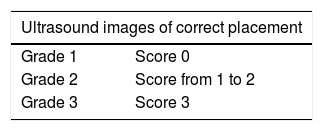To evaluate clinical usefulness of ultrasound images of the upper airway in order to check correct laryngeal mask placement.
Material and methodsA prospective observational study was conducted on patients scheduled for abdominal surgery under general anaesthesia, in whom the patency of the upper airway was ensured using an Ambu®AuraGain™ laryngeal mask. An ultrasound scan was performed of the upper-airway in the cranio-caudal direction and with longitudinal scans in the anterior midline and parasagittal axis, in three moments: before, after inserting and after removing the mask. All recorded images were evaluated for a second time by an expert radiologist in upper-airway ultrasound. Subsequently, the ultrasound data were related to the clinical difficulty of the insertion and presence of air leaks.
ResultsData were collected from 30 patients (20 females and 10 males) being operated on for abdominal hysterectomy (15), eventroplasty (6), uterine myomectomy (3), and umbilical (4) and inguinal herniorrhaphy (2). The blind insertion of the masks did not present difficulties in 24 (80%) patients. Air leakage was detected in eight (26.7%) patients, which was moderate in seven cases and severe in one. The ultrasound findings confirmed good mask placement in 22 (73.3%) patients. Anatomical airway changes after laryngeal mask extraction were only observed in three (12%) patients, all of them minor. There was a statistically significant association (p<0.05) between difficulty in inserting the device and the level of air leakage.
ConclusionsUpper-airway ultrasound is a useful diagnostic method to evaluate laryngeal mask placement. Laryngeal oedema was not observed after removal of the device.
Evaluar la utilidad clínica de la ecografía de vía aérea superior en la visualización de la mascarilla laríngea correctamente insertada.
Material y métodosEstudio observacional prospectivo en pacientes programados para cirugía abdominal bajo anestesia general, a quienes se aseguraba la permeabilidad de la vía aérea mediante mascarilla Ambu®AuraGain™. Se llevó a cabo un escaneo ecográfico de la vía aérea superior, mediante cortes trasversales en sentido cráneo-caudal y cortes longitudinales en línea media cervical anterior y parasagital, en tres momentos: antes, tras insertar y tras retirar la mascarilla. Las imágenes registradas eran evaluadas en un segundo tiempo por un radiólogo experto en ecografía de la vía aérea. Posteriormente, se relacionaban los datos ecográficos con los clínicos de dificultad de inserción y presencia de fuga aérea.
ResultadosRecogimos datos de 30 pacientes (20 mujeres y 10 varones) intervenidos de histerectomía abdominal (15), eventroplastia (6), miomectomía uterina (3) y hernioplastia umbilical (4) e inguinal (2). La inserción a ciegas del dispositivo no presentó dificultades en 24 pacientes (80%). Detectamos fuga aérea en 8 pacientes (26.7%): moderada en 7 casos y grave en uno. Los hallazgos ecográficos confirmaban buena colocación de la mascarilla en 22 pacientes (73,3%). Se objetivaron cambios anatómicos en la vía aérea tras extraer la mascarilla laríngea en 3 pacientes (12%), todos leves. Hubo asociación estadísticamente significativa (p<0,05) entre el grado de dificultad de inserción del dispositivo y el grado de fuga aérea detectado.
ConclusionesLa ultrasonografía de la vía aérea superior podría confirmar la colocación correcta de la mascarilla laríngea. No se objetivó oedema laríngeo tras la extracción del dispositivo.











